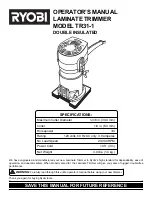
Seven
O’Clock
OK To Cut
Blade
Rotation
DO NOT CU
T
Five
O’Clock
Eleven
O’Clock
Using A Brushcutter Blade T272X
WARNING!
n
Before working with a blade-
equipped unit, always inspect
and clean the area of objects that
could interfere with or damage the
blade.
n
Never use a blade near sidewalks,
fence posts, buildings or other
objects that could cause injury or
damage.
n
Never use a blade for purposes
other than those for which it
was designed.
n
Whenever you strike a hard object
with a blade, always stop the
brushcutter and carefully inspect
the blade for damage. NEVER
OPERATE THE UNIT WITH A
DAMAGED BLADE!
n
A blade-equipped unit must be
equipped with a bicycle-type
handlebar or barrier bar as well as
a harness or shoulder strap.
n
Always make sure the cutting
attachment shield is properly
installed before operating this unit.
OPERA
TION
Engine Operating Speeds
Operate the unit at full throttle
while cutting. Best fuel efficiency is
obtained by releasing the throttle
when swinging back after a cut.
n
To prevent possible engine damage, do
not allow the brushcutter to operate at
high speeds without a load.
n
Avoid cutting at low engine speeds. Do-
ing so can lead to rapid clutch wear. In
addition, slow-speed operation tends to
cause grass and debris to wrap around
the cutting attachment.
WARNING!
When making vertical cuts, never al-
low the blade to exceed waist height.
The blade rotates counter-clockwise.
For best performance and to minimize
being stuck by debris, move the blade
from right to left while advancing on
your work.
Position the blade so cuts are
made between the blade’s 7 o’clock
and 11 o’clock positions (as viewed
from above). DO NOT cut between
the 11 o’clock and 5 o’clock posi-
tions. See Figure 25.
Cut on the left side
of the blade. KEEP
YOUR BODY OUT-
SIDE THE PATH OF
BLADE ROTATION
Vertical cuts
Hold the trimmer with the blade at a
90° angle to the ground so the blade’s
bottom edge rotates toward the opera-
tor.
Move the blade from top to bottom
through the cut, and cut
only
with
the bottom edge of the blade.
Figure 26
Figure 25
12
WARNING!
n
When cutting wood with a blade,
feed the blade slowly.
Never strike or “slam” the spin-
ning blade against the wood.
n
DO NOT use 2-tooth or non-
Shindaiwa approved 4-tooth
cutting blades with Shindaiwa
trimmers and brushcutters.
Blade Thrust
‘Blade thrust’ is a sudden sideways
or backward motion of the brushcut-
ter. Such motion may occur when
the blade jams or catches on an
object such as a sapling tree or tree
stump. BE CONSTANTLY ALERT
FOR BLADE THRUST AND GUARD
AGAINST ITS EFFECTS!
Brushcutter Handlebar
A brushcutter’s handlebar helps
prevent the operator from moving
forward or the unit moving rearward;
thus preventing inadvertent bodily
contact with the blade. ALWAYS
KEEP THE HANDLEBAR SECURELY
IN PLACE ON THE UNIT!
Shoulder Strap
A shoulder strap provides additional
protection against blade thrust. Plus,
a shoulder strap gives significant sup-
port and comfort to help ensure safe
and efficient operation.
When operating a blade equipped
trimmer, make sure the shoulder
strap is adjusted properly to the op-
erator using the unit.
Содержание 80974
Страница 17: ...TROUBLESHOOTING Troubleshooting Guide continued LOW POWER OUTPUT What To Check Possible Cause Remedy 17 ...
Страница 18: ...Troubleshooting Guide continued ADDITIONAL PROBLEMS TROUBLESHOOTING Symptom Possible Cause Remedy 18 ...
Страница 37: ...Diagnóstico Sp 17 GUIA DIAGNOSTICO continuación BAJA POTENCIA Que Revisar Posible Causa Remedio ...
Страница 38: ...GUIA DIAGNOSTICO continuación PROBLEMAS ADICIONALES Sp 18 Síntoma Posible Causa Remedio Diagnóstico ...













































